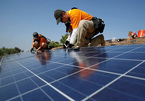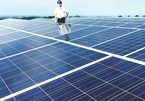As at June 30, 89 solar power plants had been put into operation and connected to the national grid, according to Electricity of Vietnam (EVN).
The total capacity of 4,543MW is, however, far in excess of the 850MW by 2020 envisaged in the country’s power plan.
The solar power boom heated up since Prime Ministerial Decision No.11/2017/QD-TTg on mechanisms for encouraging the development of solar energy was issued in 2017.
Vietnam is now moving in the same direction as other countries in renewable energy utilization, but limitations remain that the country must consider regarding availability and the cost of electricity produced by renewable energy.
Excess capacity
Attracted by a feed-in tariff (FiT) of 9.35 US cents for solar power projects, investors have been lining up for approval to generate gigawatts of power in Vietnam’s central and south-central provinces, where solar irradiation is the strongest.
The grid, however, is not ready to handle the onslaught, putting renewable energy projects at risk and providing a valuable lesson for planners and latecomers.
Solar power projects are now concentrated in south-central Binh Thuan and Ninh Thuan provinces, and the consequences have affected both the grid and investors in both solar and wind power projects in these areas.
Such problems are yet to be seen in other provinces. Ms. Vu Chi Mai, Head of Component for Renewable Energy at GIZ, explained that since the FiT mechanism under Decision No.11 was only valid for two years, investors worked at full capacity to put their projects into operation before end-June, to enjoy the existing price policy.
Grid congestion is a massive challenge requiring a re-design of the grid strategy, according to Mr. Gavin Smith, Director of Clean Development at Dragon Capital.
“Past grid-planning was focused on servicing massive coal complexes, but it now has to service a diverse set of renewable power plants in solar and wind,” he said.
Regarding the grid connection process, Mr. Pham Minh Tuan, Deputy General Director of the Bamboo Capital Group (BCG), said the national power transmission system as well as the number of substations are still limited. In addition, investment in electricity transmission is quite expensive and difficult, as some projects require transmission lines of up to 30 km.
In terms of finance, foreign banks are unable to participate despite expressing interest, so investors must borrow capital from domestic banks at high interest rates. Site clearance for plants as well as power transmission lines is also very difficult, because it requires large areas and affects local people’s lives, which all lead to high implementation costs.
Issues to tackle
Not all areas of the power transmission and distribution network in Vietnam are affected by grid limits.
Mr. Tuan therefore recommended that new solar power projects be encouraged to develop in provinces where the grid is still capable of absorbing renewable energy, and that petitions be sent to the government on allowing private investment in the construction of transmission lines, which should then be reported to the Prime Minister for a special mechanism on deploying anti-overload electricity to 2020.
Senior leaders at EVN confirmed it will free up all of the capacity of solar power plants by the end of 2020 by whatever means necessary.
Over the next two years, the group will focus on investing in power grids to minimize requests to reduce generation capacity at solar power projects. For investors, in BCG’s experience, location selection is very important for the project to avoid overloads.
Moreover, Vietnam should learn lessons from many other countries in regulating renewable power sources based on two elements: the FiT being guaranteed for 20 years with a preference for generating renewable power, and green energy investors being compensated by grid operators in case of electricity grid congestion.
This shows that it’s important to create a secure and stable investment environment to attract renewable energy investors.
The lessons from many countries suggest that it’s possible to optimize the transmission capacity of existing grid infrastructure and increase the flexibility of electrical systems.
By applying such measures and new technologies, grid congestion and restrictions on renewable energy can be minimized.
Meanwhile, land, licenses, and finance are of continuing concern for independent power developers.
“The lack of any international project finance in Vietnam pushes up our cost of capital by 30 per cent, making clean energy unnecessarily expensive for EVN and ultimately for Vietnam’s electricity consumers,” said Mr. Smith.
“Barriers in the PPA [power purchasing agreement] that limit international bank access to the clean energy market are damaging investor sentiment and the unnecessarily high cost of clean energy is harming economic growth prospects in Vietnam.”
Vietnam needs to see a rapid expansion of power generation to ensure stable supply of electricity by the spring of 2021 in the south.
The coal plan has failed to deliver, and solar/wind power is the fastest, least expensive solution. It may be that power market planners currently considering Power Development Plan No. 8 believe that there are more than enough clean energy projects vying for approval to proceed without amending the PPA, Mr. Smith added.
New mechanism needed
The nature of the FiT is to ensure basic profits for investors, but besides having advantages in encouraging and promoting renewable energy development, the FiT mechanism also has certain limitations and deprives advantages in the dispersion of renewable energy, especially wind and solar power.
Based on the FiT, solar developers will choose to develop projects in areas with higher radiation, which leads to projects tending to focus strongly on the highest potential areas of solar radiation and then spreading to other areas after those are filled.
|
"Vietnam needs to see a rapid expansion of power generation to ensure stable supply of electricity by the spring of 2021 in the south. The coal plan has failed to deliver, and solar/wind power is the fastest, least expensive solution. It may be that power market planners currently considering Power Development Plan No. 8 believe that there are more than enough clean energy projects vying for approval to proceed without amending the PPA.”
|
Therefore, in order to promote the advantages of the FiT mechanism, according to GIZ, many countries have applied Zonal FiT mechanisms to continue encouraging renewable energy development in the context of promoting scattered investment on a wider scale.
A Zonal FiT mechanism has been proposed in the new Draft Policy on FiT Post-30 June 2019 for Solar Power, submitted by the Ministry of Industry and Trade (MoIT), in which Vietnam is divided into two potential areas instead of four in the previous draft, based on the irradiance zonal classification of cities and provinces.
With the application of a Zonal FiT, Ms. Mai noted, project investment would spread to regions and developers could choose the best projects in different areas rather than just concentrating on one.
“This would avoid rapid investment pressure creating large volumes of renewable energy for the power grid to absorb,” she said.
Thus, zonal FiT supports more efficient grid operation and management and minimizes the risk of curtailment of capacity at solar PV projects in case the grid is overloaded.
Regardless of whether the draft decision is finalized in the near future, the current FiT of 9.35 US cents will definitely be changed due to a reduction in technology costs for solar power production.
The FiT and the ability to absorb electricity into the grid are currently major concerns for solar power developers.
“We understand that the efficiency of solar power projects depends largely on natural conditions or the irradiance in specific areas,” said Mr. Tuan from BCG.
“Therefore, the new FiT mechanism is completely reasonable. Besides, technological development is leading to a reduction in the cost of construction materials and techniques, so the government made the adjustment to the PPA accordingly.”
He highly recommended, however, that the country needs stable and long-term policies to ensure capital security for investors so they can develop long-term projects.
“BCG’s goal is to provide 1,000MW of renewable energy to the national grid by 2021,” he added. “With policy changes, we will recalculate the feasibility of projects and continue implementation to realize our goals.” VN Economic Times
Hong Nhung

Experts warn of technical problems when developing solar power in Vietnam
With limitless potential, solar power is expected to become the solution for Vietnam to ease reliance on fossil fuel. However, after four years of mass deployment, many problems have arisen, including environmental risks.

Investors wait for new solar electricity prices
The preferential electricity purchase price of 9.35 cent per kwh expired one month ago, but the new price has not been fixed.
 After rushing to connect to the national grid prior to end-June to benefit from price policies, solar power developers have now found that the grid can't handle the extra capacity.
After rushing to connect to the national grid prior to end-June to benefit from price policies, solar power developers have now found that the grid can't handle the extra capacity.